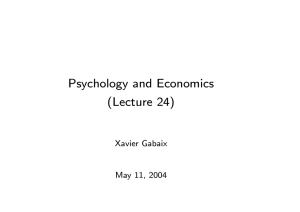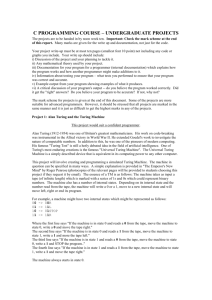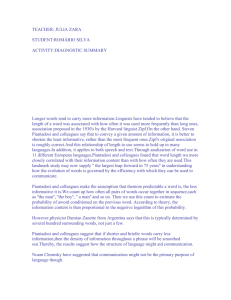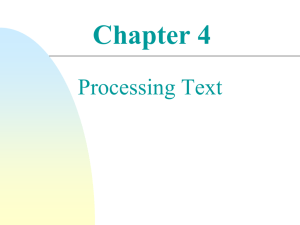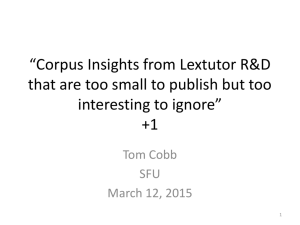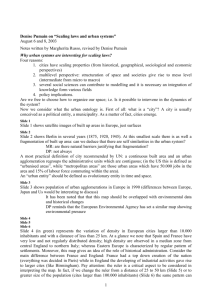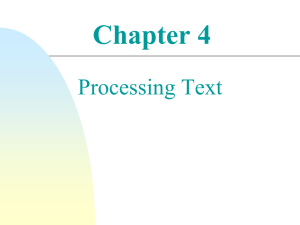Zipf Law Revisited: A Model of Emergence and Manifestation
advertisement
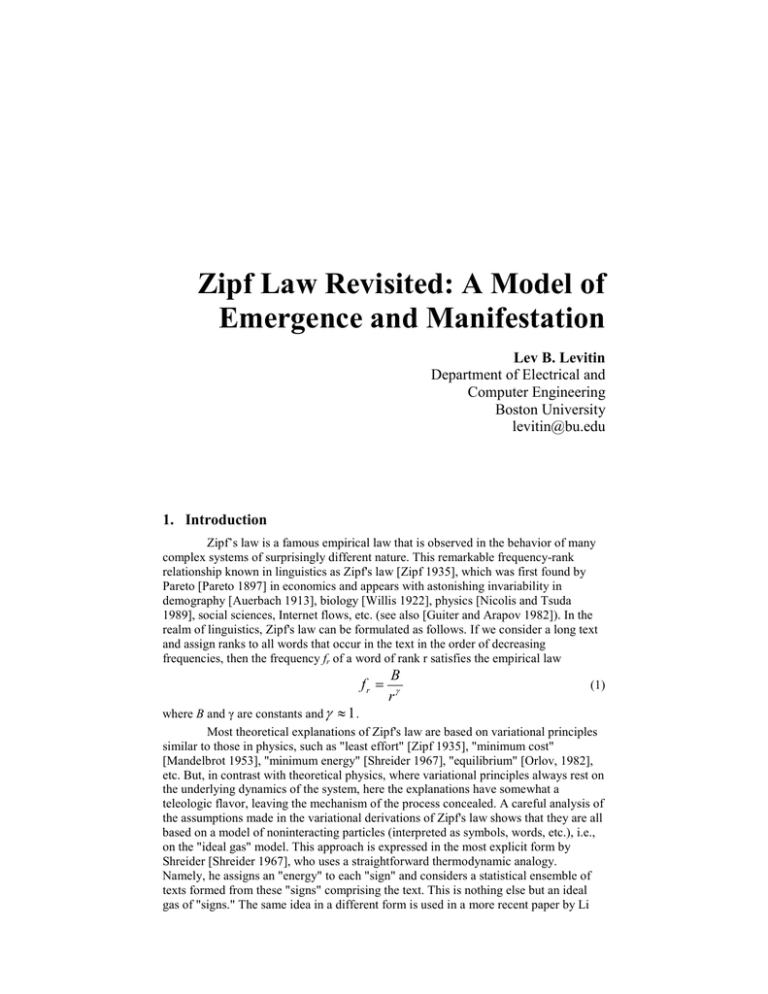
Zipf Law Revisited: A Model of
Emergence and Manifestation
Lev B. Levitin
Department of Electrical and
Computer Engineering
Boston University
levitin@bu.edu
1. Introduction
Zipf’s law is a famous empirical law that is observed in the behavior of many
complex systems of surprisingly different nature. This remarkable frequency-rank
relationship known in linguistics as Zipf's law [Zipf 1935], which was first found by
Pareto [Pareto 1897] in economics and appears with astonishing invariability in
demography [Auerbach 1913], biology [Willis 1922], physics [Nicolis and Tsuda
1989], social sciences, Internet flows, etc. (see also [Guiter and Arapov 1982]). In the
realm of linguistics, Zipf's law can be formulated as follows. If we consider a long text
and assign ranks to all words that occur in the text in the order of decreasing
frequencies, then the frequency fr of a word of rank r satisfies the empirical law
fr =
B
rγ
(1)
where B and γ are constants and γ ≈ 1 .
Most theoretical explanations of Zipf's law are based on variational principles
similar to those in physics, such as "least effort" [Zipf 1935], "minimum cost"
[Mandelbrot 1953], "minimum energy" [Shreider 1967], "equilibrium" [Orlov, 1982],
etc. But, in contrast with theoretical physics, where variational principles always rest on
the underlying dynamics of the system, here the explanations have somewhat a
teleologic flavor, leaving the mechanism of the process concealed. A careful analysis of
the assumptions made in the variational derivations of Zipf's law shows that they are all
based on a model of noninteracting particles (interpreted as symbols, words, etc.), i.e.,
on the "ideal gas" model. This approach is expressed in the most explicit form by
Shreider [Shreider 1967], who uses a straightforward thermodynamic analogy.
Namely, he assigns an "energy" to each "sign" and considers a statistical ensemble of
texts formed from these "signs" comprising the text. This is nothing else but an ideal
gas of "signs." The same idea in a different form is used in a more recent paper by Li
2
Zipf’s Law Revisited
[Li 1992]. He assumes that symbols (including the "blank space") are generated
independently with equal probabilities and shows that this results in (approximately)
Zipf's law for the frequencies of words in a long text. Independence of symbols means,
of course, absence of interaction, which brings us again to the ideal gas model.
Consequently, the author comes to the conclusion that "Zipf's law is not a deep law in
natural language as one might first have thought."
We believe the situation is not so trivial. The fact that simple structureless
systems can display Zipf-law-like distributions does not preclude Zipf's law--together
with more subtle characteristic features--from reflecting mechanisms that govern the
behavior of complex systems. Models of such behaviors should be essentially based on
the interaction and interdependence of the components of the system and lead to
empirically verifiable conclusions different from those provided by "ideal gas" models.
A model of the development of an evolutionary system in the form of a nonstationary
branching Markov process has been suggested in [Levitin and Schapiro 1993], and
[Günther et al. 1996]. Under very simple and general assumptions, this model leads to
Zipf's law for the expected values of species populations in an ecosystem. Apparently
this is the first model that provides a theoretical explanation of Zipf's law based on a
nontrivial interdependence of the system components.
Another result which may prove to be important is the stepwise behavior of the
ranked expected values in the evolutionary model, in contrast to the smooth Zipf-law
behavior of the expected values for the unranked (original) species population numbers.
This result is due to the broadness of the distributions of the population numbers in our
model, as opposed to narrow (binomial type) distributions in the "ideal gas" models.
Thus, there exists an opportunity, by comparison with empirical data, to obtain crucial
evidence as to which model relates to reality.
2. An Evolutionary Model
Here we present a model of the development of an evolutionary system
suggested in [Levitin and Schapiro 1993] in the form of a nonstationary branching
Markov process. We will formulate the model in the language of ecological dynamics,
though it can be easily reformulated in terms of demography, linguistics, Internet
statistics, etc. Henceforth we will denote random variables by capital letters and their
values by lowercase letters.
Consider an ecosystem which consists of populations Nk(N) [k = 1, 2, . . A(N)]
of species sk, where N is the number of steps of the process interpreted as time (time is
discrete in this model), Nk(N) is a random variable which is the population of species sk
at time N, and A(N) is the (random) number of different species at the Nth step of the
process. The system is assumed to evolve according to the following rules.
1. At the (N + l)th step of the process exactly one individual is created.
The probability that the newly created individual belongs to the species sk is
proportional to the population of that species at time N.
Pr{Nk (N +1) = nk +1 | Nk ( N ) = nk } = Pk ,N +1(nk +1 | nk ) = (1− c( N ))
nk
N
(2)
2. The probability that an individual of a new species sA(N)+1 will be created at
the (N + 1)th step of the process (probability of a successful mutation) is
Pr{NA( N )+1(N +1) = 1 | N A( N )+1(N ) = 0} = PA+1,N+1 = c( N )
(3)
3
L.B. Levitin
It is mathematically convenient to introduce a "fictitious species" s0 that "preexisted" at
time N = 1. The birth of an individual of s0 can be interpreted as the "noncreation" of an
individual of any "real species" sk. (The linguistic interpretation would be generation of
the "empty word.") Then the initial conditions can be expressed as
N0(1) = 1,
A(1) = 0
(4)
and for any N
A( N )
A( N ) +1
k =0
k =0
∑ Nk (N ) = N,
∑P
k , N +1
=1
Formulas (2)-(4) define a branching Markov process.
We will analyze the behavior of the expected values E(Nk) and the average
frequencies fk(N) = E(Nk(N))/N. Consider two special cases corresponding to two
different assumptions about the mutation rate.
1.
c( N ) = c = const , c << 1
(5)
Then, the expected number of species at step N is
E ( A( N )) = 1 + ( N − 1)c
(6)
Calculation of the explicit expression of E(Nk(N)) is complicated by the fact
that the step N(k) when species sk appears is a random variable. After an
intricate derivation, we obtain:
c k k −1 1 − c j ( −1) k − j +1
c ln c
+ (−1) k +1
E ( N k ( N )) = N
∑
j +1
1 − c
1 − c j = 0 c
1− c
(7)
Hence, for N>>1, c<<1, the expected values and frequencies of species,
numbered by the order of their appearance, are asymptotically equal to
1− c
cN
E ( N k ( N )) ≈
k
,
fk ( N ) ≈
c1− c N − c
k 1− c
(8)
which is Zipf’s law (with the exponent slightly smaller than 1).
2.
Now assume that the probability of mutation leading to the emergence of a
new species decreases with time:
c( N ) = bN − q , where q<<1.
(9)
Then the expected number of species grows slower then N:
E ( A( N )) =
b
N 1− q
1− q
(10)
For large ranks k>>1 the frequencies are
b
fk (N ) =
(1 − q )k
1
1− q
q
1− q
b
b
b
+
exp −
q (1 − q )k
qN q
(11)
Zipf’s Law Revisited
4
This is also Zipf’s law, since the exponential factor is almost constant for b<<1, q<<1.
For example, if b=0.1, q=0.1, the factor changes from 0.45 to 1 when i changes from 1
to infinity. In contrast with case 1 (q=0), now the exponent in Zipf’s law is larger then
1, and there exists a counterpart of thermodynamic limit (N→∞) for the average
frequencies:
q
1
b 1−q
b b 1− q
(12)
−
f k = lim f k ( N ) =
exp
q (1 − q)k
N →∞
(1 − q )k
3. Information Complexity
Let us address now the question of the complexity of the system described by
our model. We expect intuitively that a “good measure” of complexity should reflect
both “unpredictability” and “organization” (which implies memory) in the behavior of a
complex system. We suggest, as a measure of complexity at time N, the mutual
information between two successive states of the system sN and sN-1.
C N = I ( sn ; s n−1 ) = H ( s n ) − H ( s n | s n−1 )
(13)
This measure agrees with our intuition since it is nonnegative and vanishes for both
extreme cases of chaotic (i.e. memoryless) systems and, on the other hand, strictly
deterministic systems.
In our model the state sN is a random vector with a random number A(N) of
components
s N = ( N1 ( N ), N 2 ( N )..., N A( N ) ( N ))
(14)
For large N, we can consider random variables Ni(N) as almost independent. Then in
case 1, approximately,
CN ≈
π2
6
cN − (1 − c) ln N
(15)
Thus, the limit complexity per one component of the system (one species) is
CN
π2
=
nats,
N →∞ E ( A( N ))
6
~
Clim = lim
(16)
or 2.37 bits per species.
Similar analysis in case 2 gives the same limit complexity per species (specific
complexity) for q<<1. Apparently, this complexity is characteristic for all systems
which obey Zipf’s law with the exponent close to one.
4. The Effect of Ranking
The behavior of the expected values E(Nk) is not sufficient to explain the
empirically observed Zipf-law-like distributions. As shown in [Günther et al. 1992], the
probability distribution for a single species has an asymptotically exponential
(geometric) form (N >> 1):
pk,N (nk ) = Pr{N k ( N ) = nk } = ak (1 -ak )
nk −1
,
(17)
5
L.B. Levitin
where
1−c
k
a k =
cN
(18)
This is a very broad probability distribution with the standard deviation of the
same order of magnitude (in terms of N) as the expected value. Since any empirically
observed set of population values is just one random sampling (realization) of the set of
random variables {Nk}, these values listed in the order of species would exhibit a
chaotic nonmonotonic behavior, and one would not be able to observe Zipf's law at all!
Indeed, looking at Fig. 1 (gray line), it is impossible to recognize Zipf's law in the
chaotically fluctuating population values. However, after ranking the same population
values in decreasing order, we obtain a much smoother monotonic curve (Fig. 1, solid
line) from which Zipf's law can be easily discerned. This phenomenon is explained by
~
the fact that the probability distributions for the new random variables N r , which are
populations of a given rank r, are much narrower than those for Nk -- the populations of
the species. Numerical results demonstrating this effect have been presented in
[Gtinther et al. 1996]. Consequently, a single realization can serve as a typical
representative of the entire statistical ensemble. (Note that different species may
occupy the same rank in different realizations.)
Figure. 1 The gray line shows one realization of the process defined by equations (2)-(4), with
the parameters c = 0.02 and N = 40,000. The x axis is the species number as determined by
the creation time of this species. The black curve shows the same realization, but now ranked
according to the values nk and plotted against rank. Note the smoothness of this curve.
Obviously, the curve for the expected values of the ranked variables is, in
general, steeper than that for the unranked ones. However, it turns out that, in the case
of Zipf’s law with exponent γ close to 1 (c→0), the expected values of ranked
populations
~
E ( N r ) follow the same law for r>>1 as E ( N k ) . Namely, with good
approximation,
Zipf’s Law Revisited
6
A −1
1 A − 1
~
E(N r ) ≈
exp − ≈
(19)
,
r r
r
A
which is close to E ( N k ) =
. However, in contrast with expected values for
k
~
unranked variables, E ( N r ) demonstrate a characteristic “staircase” behavior, which is
~
due to the floor function. More exactly, the expected values E ( N r ) are still changing
continuously, but with alternating “steep” and “flat” intervals. This "staircase" shape of
~
the curve for E ( N r ) should not be confused with the steps observed in any empirical
realization due to the discreteness of the population numbers. The steps in the expected
values curve appear as a result of the ranking procedure, i.e., the transition from {N k }
~
to {N r } , due to the fact that the distribution (17) is very broad. More careful analysis
leads to the conclusion that, in fact, the curve remains smooth up to larger ranks. The
r ≥ 3 A 2 / 3 . The length of the ith step, i.e. the interval
~
(ri +1 , ri ) for which E ( N r ) ≈ i is approximately equal to
A − 1 ri +1ri
(∆r ) i = ri − ri +1 ≈
=
(20)
i (i + 1) A − 1
These results remain valid for γ ≠ 1, provided that c = 1 − γ <<1. However, the
~
exponent of Zipf’s law for N r becomes slightly larger then that for Nk. A numerical
"steps" become visible if
example given in Fig. 2 demonstrates excellent correspondents between theoretical and
simulated data.
Figure. 2 Comparison between theory and simulation. Parameters used are N = 6000, A = 1000,
~
and γ = 0.95. Shown are the theoretical E ( N r ) (black) and an ensemble average (gray) of a
numerical simulation. The “staircase” behavior is observed for sufficiently large ranks.
L.B. Levitin
7
5. Conclusions
One may conclude that the ubiquitous appearance of Zipf's law is based on two
independent effects. The first is the fact that very general transition probabilities lead to
Zipf's law. The second reason why Zipf's law is found so often is probably based on the
ranking procedure, which makes Zipf structures empirically observable because they
are robust under its application.
Let us reiterate that the model from [Günther et al. 1996] is the first one that
not only leads to the overall Zipfian behavior, but predicts a new, verifiable
phenomenon: the deviations from the "ideal" Zipf law in the form of the "staircase"
behavior of the expected values. Thus, our model suggests the emergence of a secondtier structure of “superclasses” – groups of classes with almost equal populations.
Acknowledgments
The author would like to express his most cordial thanks to K. Aizikov
(Boston University) for his indispensable assistance in preparation of this paper.
References
Auerbach, F., 1913, Das Gesetz der Bevökerungskonzentration [The law of population
concentration], Petermans Mitteilungen, 59, 74.
Frankhauser, P., 1991, The Pareto-Zipf-distribution of urban systems as stochastic process, in
Models of Selforganization in Complex Systems, W. Ebeling, M. Peschel, and W. Weidlich,
eds., Akademie Verlag, Berlin.
H. Guiter and M. V. Arapov, eds., 1982, Studies on Zipf's Law, Studienverlag Dr. N.
Brockmeyer,
Günther, R., Schapiro, B., and Wagner, P., 1992, Physical complexity and Zipf's law,
International Journal of Theoretical Physics, 31, 525-543.
Günther, R., Levitin, L., Schapiro, B., and Wagner, P., 1996, Zipf’s Law and the Effect of
Ranking on Probability Distribution. Intern. Journal of Theoretical Physics, 35, No.2, 395417.
Katsikas, A. A., and Nicolis, J. S., 1990, Chaotic dynamics of generating Markov partitions and
linguistic sequences mimicking Zipf's law, Nuovo Cimento, 12D, 177.
Kohonen, T., 1982, Analysis of a simple self-organizing process, Biological Cybernetics,44, 135140.
Levitin, L. B., and Schapiro, B., 1993, Zipf's law and information complexity in an evolutionary
system, in Proceedings IEEE International Symposium on Information Theory, San Antonio,
Texas, p. 76.
Li, W., 1992, Random texts exhibit Zipf's-law-like word frequency distributions, IEEE
Transactions on Information Theory, 38, 1842.
Mandelbrot, B. B.,1953, An information theory of the statistical structure of language, in
Communication Theory, W. Jackson, ed., London, pp. 486-502.
Mandelbrot, B. B.,1983, The Fractal Geometry of Nature, Freeman, New York.
Nicolis, J. S., and Tsuda, I., 1989, On the parallel between Zipf's law and l/f process in chaotic
systems possessing coexisting attractors, Progress of Theoretical Physics, 82, 254-274.
Orlov, J. K., 1982, Ein Modell der Häufigkeitsstruktur des Vokabulars, in Studies on Zipf's
Law,H. Guiter and M. V. Arapov, eds., Studienverlag Dr. N. Brockmeyer, Bochum,
Germany.
Pareto, V., 1897, Cour d'Economie Politique, Lausanne and Paris [reprinted in Oevre
Completes,Genf Droz].
Shreider, Yu. A., 1967, Theoretical derivation of text statistical features, Problemy Peredachi
lnformatsii(Problems of Information Transmition), 3, 57-63.
Willis, J. C., 1922, Age and Area, Cambridge University Press, Cambridge.
Zipf, G. K., 1935, The Psychobiology of Language, Houghton-Miflin, Boston.
Zipf, G. K., 1949, Human Behavior and the Principle of Least Effort, Addison-Wesley,
Cambridge, Massachusetts.
